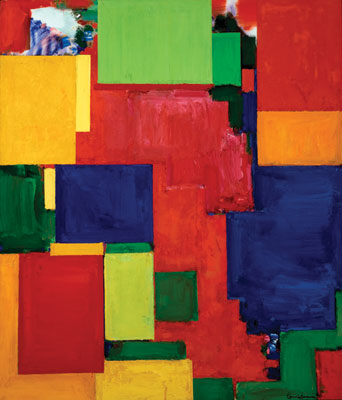Colorscope at the Santa Barbara Museum of Art
Abstract Paintings from the 1960s and 1970s Hang Through August 15

Give an outstanding curator the right collection and she will surprise you, and maybe even move the world. That’s the happy impression with which one leaves Colorscope, an exhibit put together by Julie Joyce and on view through August 15 at the Santa Barbara Museum of Art. It’s a survey of abstract painting over the course of two decades that produces wonder at the depth and range of the museum’s permanent collection and delight at the integrity of the paintings that followed the initial popularity of abstract expressionism. Mixing California artists with East Coasters, the show includes everything from hard-edged abstraction to airbrush techniques and traditional gesture-based oil painting. The unifying quality of these works—besides their extravagant use of strong colors—is dedication to Josef Albers’s dictum that the source of art is “the discrepancy between physical fact and psychic effect.”
The show’s first optical assault comes from Richard Anuszkiewicz, whose “Centered Green” (1979) occupies the far wall of the first gallery. With its vibrant use of complementary colors, the picture actually appears to be emitting light, and looking at it literally tickles the optic nerve.
Elsewhere in the same room, June Harwood’s “Loop (Target)” from 1965 shows how effectively this relatively unknown California painter adapted the “hard-edge” style. Next to the Harwood is another truly outstanding California painting by Lorser Feitelson, “Untitled, April 21, 1971.” The picture’s all-over black surface is interrupted only once by a single swooping zip of red that cuts the canvas vertically. Feitelson playfully transforms Barnett Newman’s iconic gesture of transcendence into something sexy and new with this elegant, intelligent work.
SBMA owns some extraordinary and important large canvases, and this show has the virtue of pulling several of them out of storage. There’s a great Hans Hofmann, “Simplex Munditis” (1962), that’s every bit as good as the ones hanging in MOMA. In the second room, there’s a giant painting by Larry Poons that is among the late 20th century’s most important and underrated masterpieces. “Yangtze” (1969), genuinely heroic in scale, explains so much about the transition of painting from Jackson Pollock’s “Blue Poles” of 1952 to the advent of Julian Schnabel’s notorious “plate paintings” of 1979 that it is worth going to see several times just to take in its measure. Created out of raw pigment and what looks like wax, the painting references the Chinese river of its title, both as an exercise in fluid shifts between surface and depth and as an approximation of an aerial view of the geologic makeup of the earth over time. This is a superstar of a painting, and, like the rest of Colorscope, is sure to provoke a powerful response in the eyes and minds of its viewers.



